Pistol Ammo: Save Money and Your Life [Ultimate Guide]
 Bryan Hill / March 21 2024
Bryan Hill / March 21 2024
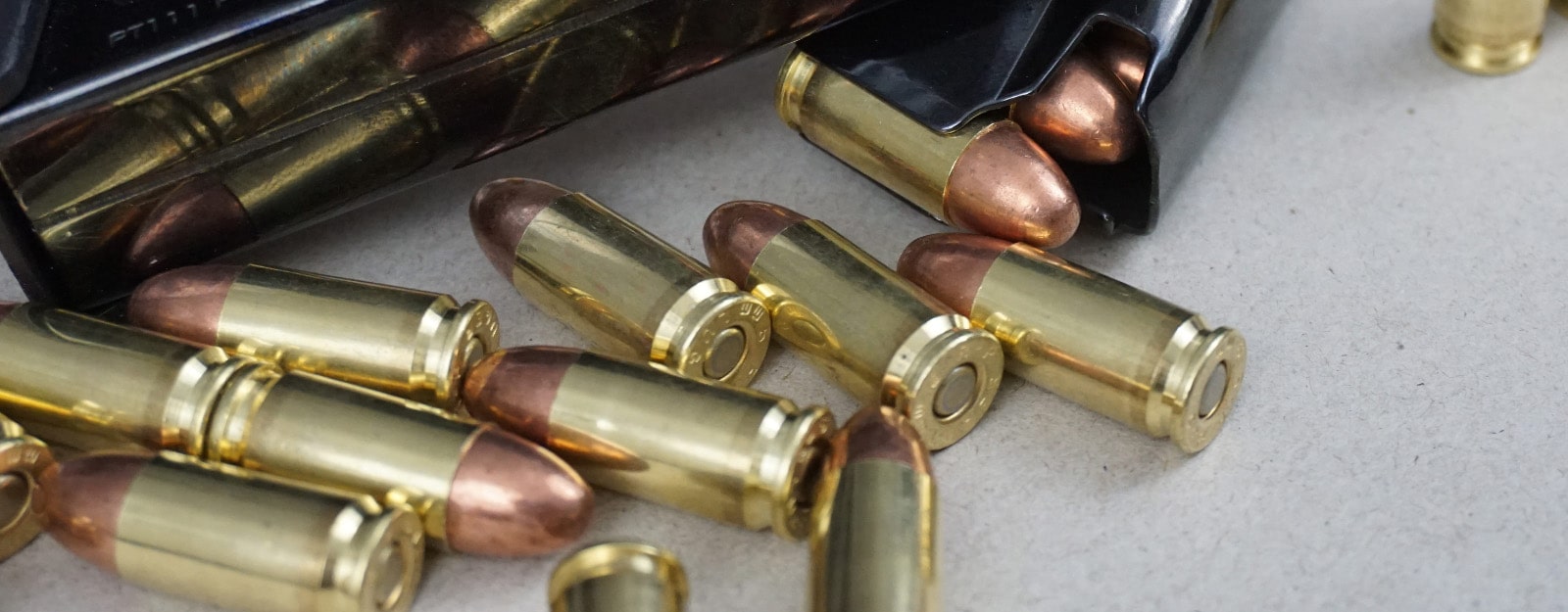
We'll cover what pistol ammo is, which calibers are best, myths about calibers and pistol shots,
and how ammo types save you money (or your life). We'll do this with real data from self defense shootings,
video of real shootings, experiments, expert testimony, and more.
On This Page:
- Basics
- What Pistol Caliber is Best?
- How Practice Ammo Saves You Money
- How Defensive Ammo Saves Your Life
- References
Basics
Ammunition (ammo) is what a pistol needs to fire.
It's stored inside the pistol's
magazine.
Ammo is composed of a few parts:
-
A bullet, which the pistol launches out when fired.
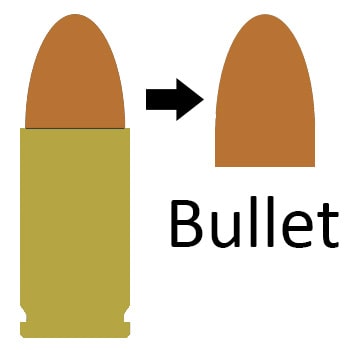
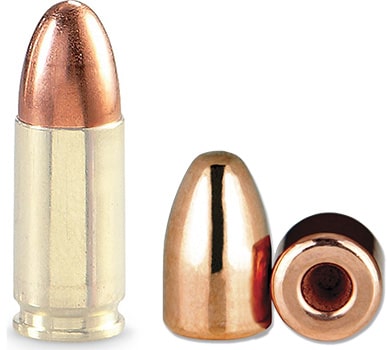
-
A casing, which contains all the other ammo parts.
When a semiauto pistol fires, the spent casing ejects out of the side of the pistol.
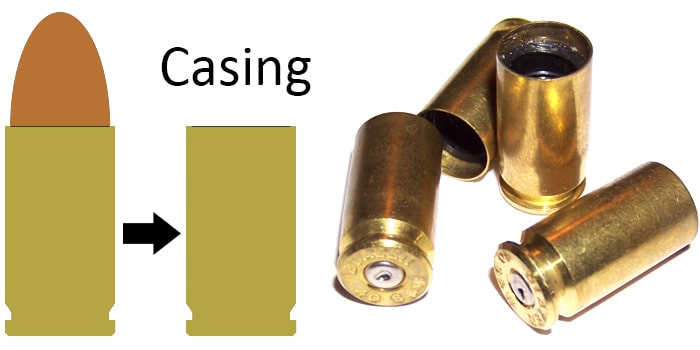
-
A Primer, which creates a spark when dented by the pistol's firing pin.
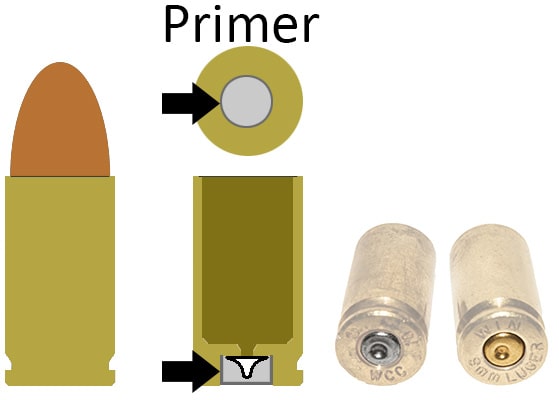
Warning: Any strike hard enough to dent the primer can ignite it.
An electrical current (like from a battery) can also cause it to ignite.
-
Gunpowder, which ignites from the primer's spark.
That creates a small explosion inside the pistol.
The pistol's barrel channels that explosion to push the bullet out.
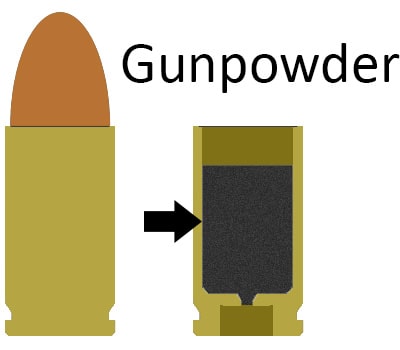
Warning: Gunpowder is highly flammable. Ammo can explode if exposed to fire.
Caliber Characteristics
BulletWidth for Effectiveness
-
Wider bullets punch larger holes, but modern defensive ammo makes caliber width less important.
-
Wider bullets lower your ammo capacity. More rounds just won't fit.
-
The minimum effective width for pistol ammo is around .38 inches, or 9mm.
CaseLength for Power
Let's look at the 9x19mm (a pistol round) vs. the 7.62x51mm (a rifle round).
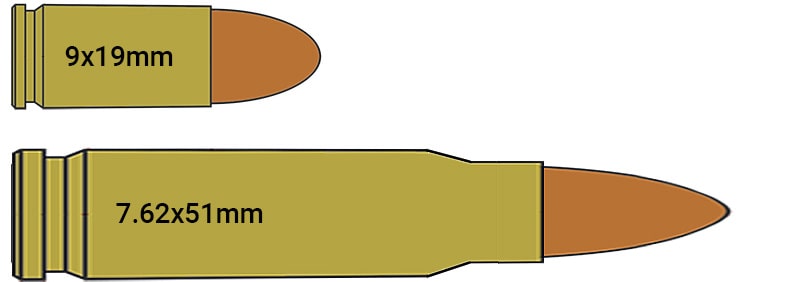
The bullet weights can be the same, but the 9mm is 9mm wide, and the 7.62's is 7.62mm wide. The 9mm has a wider bullet, so it should be more effective...
But the 7.62 is devastating compared to the 9mm. How is that?
-
Longer calibers have more gunpowder, and thus more power.
-
However, for pistols, more power often doesn't mean better performance.
-
More powerful ammo means more recoil.
-
In pistols, the key is to balance power vs. recoil.
-
Longer calibers mean bigger pistol grips,so the ammo fits in the pistol.
Shooters with smaller hands will have a harder time using good grip technique.
Cost
Each caliber costs different amounts. Cheaper is better.
Stopping Power in Pistol Calibers
A pistol can stop a threat in 3 ways:
-
Psychological stop: The threat chooses to stop being shot. This can't be relied on.
-
Blood loss: Shots to the heart or arteries stops threats every time, but takes at least 10 seconds.
-
Brain or spine damage: The only reliable way to instantly stop threats, but takes the most skill.
How does caliber affect this?
A study on 2,000 real-world shootings found that common pistol calibers:
Stop threats with one shot about the same.
Fail to stop threats about the same.
Take about the same number of shots to stop per threat.
How is this possible?
Pistols rely on
shot placement to stop threats:
We can see this in action below. No one made it out alive, but they kept fighting after taking mortal wounds:
The right caliber choice comes down to context.
What Pistol Caliber is Best?
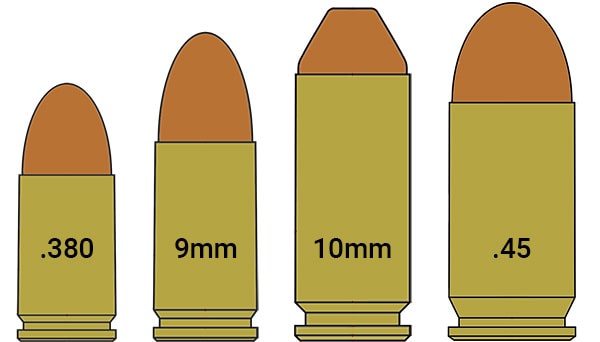
The best pistol caliber depends on your goal.
Home Defense
9mmis the best caliber for home defense. Why?
-
Modern 9mm defensive ammo is nearly as effective as larger calibers, but has more ammo capacity and less recoil.
-
It's the cheapest, so you can practice and train more.
Daily Carry
.380 ACPis the best caliber for pocket pistols under 1 lb.
Why?
-
The lighter a pistol, the worse the recoil.
-
More recoil means harder to shoot.
-
If there's too much recoil, it's impractical to practice or train with the pistol.
-
.380 has about half the recoil of 9mm.
-
New defensive .380 ammunition has proven nearly as effective as 9mm within 10 yards. That covers most self-defense encounters.
9mmis otherwise the best caliber for daily carry. Why?
-
Modern 9mm defensive ammo is nearly as effective as larger calibers, but it has much more ammo capacity and less recoil.
-
It's the cheapest, so you can practice and train more.
Bear Defense
10mmis the best caliber for defense when hiking in bear country. Why?
-
To stop a dangerous animal, one must shoot it in the brain or heart.
-
The brain and heart are protected by bones.
-
Only powerful pistols can penetrate the bones of larger animals.
-
10mm has proven powerful enough to stop large animals.
More powerful calibers than 10mm get the job done, of course. But they trade much more in ammo capacity, recoil, and cost.
An Exception
If you're considering a 9mm pistol with more capacity than your local laws allow,
.45 ACPcan be a better choice.
Why? You get a slightly more effective round without losing ammo capacity. There are still some drawbacks for .45 ACP, though:
-
It costs about twice as much as 9mm.
-
It has around 10% more recoil than 9mm.
-
The grip may be too wide compared to its 9mm version.
I Know My Caliber. Now What?
Not all ammo is created equal. Even with the right caliber, the wrong type of ammo could cost you tons of money, or fail to stop a life-ending threat.
Find out more:
How Practice Ammo Saves You Money
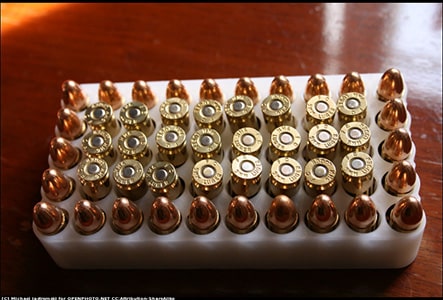
Practice ammo is made to be cheap, but not very effective. Why?
A trip to the range can easily have you fire 100-200 rounds. A training class often runs 200-300 rounds.
You may fire over 1,000 rounds in a year. Professional shooters burn through 10,000 - 20,000 rounds per year!
The costs add up fast, but so do savings.
If you save 5 cents/round, you save
$50 for 1,000 rounds, and
$500 for 10,000 rounds.
What makes ammo cheaper? What do you look for?
What Makes Good Practice Ammo?
-
It uses a basic bullet.
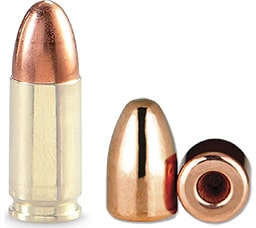
The most common kind is full metal jacket (FMJ).
A 9mm FMJ bullet punches 9mm holes in what you aim it at.
Not ideal for stopping threats, but saves money.
-
The absolute cheapest ammo uses a zinc or bi-metal jacket (steel and copper or steel and zinc) on the bullet.
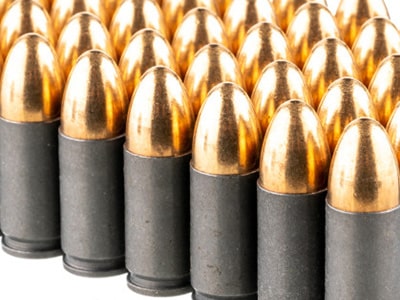
If ammo is just labeled "FMJ", it has a copper jacket.
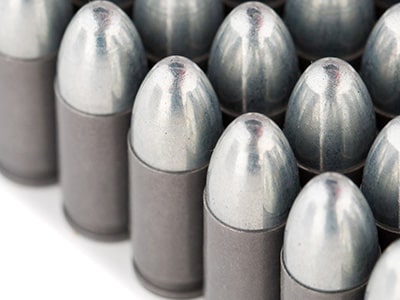
"Zinc FMJ" ammo. "Bi-metal FMJ" has a similar silvery color.
Bi-metal jackets save money, but wear out your barrel faster.
Pistol barrels last for 100,000-150,000 rounds with copper-jacketed ammo.
They wear out twice as fast with bi-metal bullets.
What saves the most money?
Barrels cost $150-200.
If bi-metal FMJ saves 1 cent a round, after 50,000 rounds you save $500.
$500 ammo savings - $200 for a replacement barrel = $300 overall savings
Do you want the extra hassle of replacing your barrel? Will you ever shoot 50,000 rounds or more through your pistol?
It's up to you. For most shooters, the cheapest practice ammo works best.
-
The casingis often steel or aluminum.
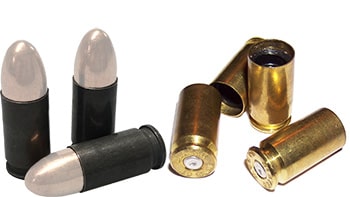
Only brass casings can be recycled,but that's such a hassle that it's only worth it for professional shooters.
-
The primersare less reliable.
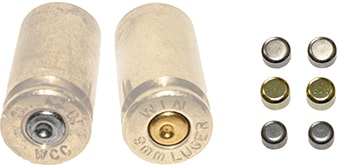
This can cause the pistol to not fire when you pull the trigger. It may require a second strike on the primer, or the primer could just be a dud.
If your pistol's firing pin and spring aren't tuned for practice ammo, your gun may jam occasionally.
-
The gunpowderis lower quality.
It will recoilless, but
if you don't tune your pistol's recoil spring for practice ammo, your gun may jam occasionally.
How Defensive Ammo Saves Your Life
When facing a deadly threat, stopping it ASAP is the top priority.
If the threat even gets an extra second to act,
that could spell death or grievous bodily harm for you or innocent bystanders.
In pistols, ammo for practice and training punches holes in targets: A 9mm round punches a 9mm hole.
However, a 9mm defensive round can punch an 18mm hole.
This can turn a near-vital shot into a vital one, and end a fight much sooner.
Defensive ammo is also made to stop inside the target, instead of passing through and endangering bystanders.
However, not all defensive ammo is made equal. The wrong kind can waste your money or blow up your gun.
Let's cover how to choose the right kind for your pistol.
Hollow Point Ammo: Effective but Finicky
Hollow points expand up to twice their width, making a mushroom shape on impact with a barrier or threat.
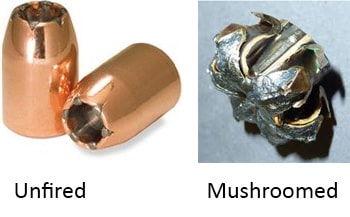
Not all hollow points are equal! The top 10% expand to 2x their normal size: 9mm becomes 18mm, etc.
Most, however, expand by around 50%: 9mm becomes about 14mm.
Even if you select the best stuff, hollow point bullets need a lot of energy to expand.
The longer your barrel, the more energy each shot has.
If the barrel is too short, hollow point bullets will work like expensive FMJ rounds.
Before you buy hollow points, check ballistics tests to see how your prospective rounds expand at that barrel length.
(Or, see our recommended defensive ammo in each of our best ammo pages, as we've already done the work for you!)
Also, consider the local weather. In cold weather, threats may wear heavier, thicker clothing.
This can reduce hollow point expansion, and you'll need more power to compensate.
Overpressure Ammo: Power with a Cost
Some defensive ammo is rated +P (overpressure).
This means extra gunpowder, and 10% more power and recoil.
That also means extra pressure in the pistol's chamber.
If your pistol isn't rated for +P ammo, that ammo can damage your pistol. It could even cause your pistol to explode in your hand!
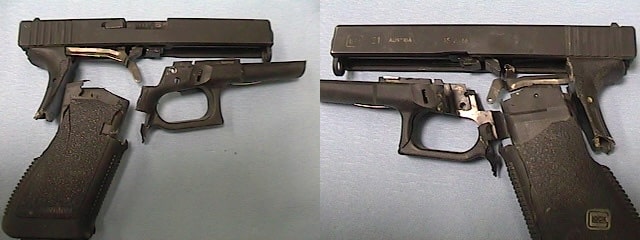
Ammo rated +P+ has about 15% more power and pressure.
+P and +P+ ammo is best with:
-
Hollow point ammo shot from a short barrel.
-
Pistols equipped with a compensator.
Say you have a 3" barrel (like in a pocket pistol), but your hollow points need a 4" barrel (like in a compact pistol) to expand.
Using +P or +P+ ammo may let you use that 3" barrel and still get full expansion from your hollow points.
Unfortunately, most small pistols aren't rated for +P or +P+ ammo.
You'd be better off with different hollow points designed for a 3" barrel.
Worse yet, most ammo manufacturers don't say what barrel length their hollow points are designed for!
Finding the right hollow points for your pistol takes time and research.
Best Defensive Ammo for Pistols?
Instead of dealing with all that, choose newer bullet designs by Lehigh Defense:
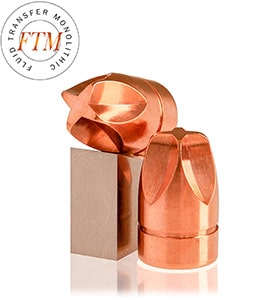 Fluid Transfer Monolithic (FTM)
Fluid Transfer Monolithic (FTM) bullets perform about 4x better than most hollow points.
They don't risk a sharp decrease in performance if your barrel is too short, or if the target wears thick clothing.
And unlike all other pistol rounds, they directly gain performance from more power.
However, FTMs penetrate barriers better than FMJ bullets.
This can be a bad thing if you miss your target.
Or, if your target is behind a barrier, FTMs may penetrate where hollow points would fail. Just be aware.
FTMs are expensive:
|
|
FTM
|
Hollow Point
|
|
Cost Per Round
|
$1.50
|
$0.75
|
|
20 Rounds
|
$30
|
$15
|
|
50 Rounds
|
$75
|
$37.50
|
FTMs perform 4x better than most hollow points, and 2x better than the best hollow points. Is the price of FTMs justified? That's up to you.
The results in hogs apply to people.
FTM rounds are the real deal and the future of defensive pistol ammo.
Find Great Ammo that Meets Your Needs
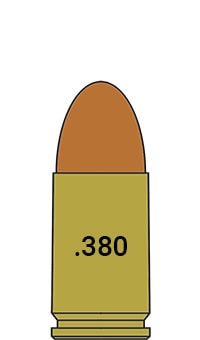
.380 ACP
.380 ACP is best for daily carry in pocket pistols under 1 lb. It has half the recoil of 9mm, but half the effective range.
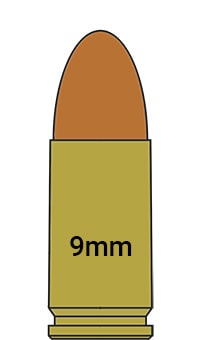
9mm Luger / Parabellum
9mm is best for home defense and daily carry in pistols over 1 lb. It's often the cheapest and easiest to find.
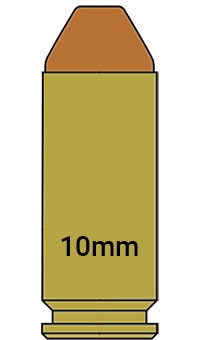
10mm Auto
10mm is best for defense against large, dangerous animals like bears. It packs the power to punch through their bones and hit vitals.
Feedback
Are you happy with this page?
References
-
2019 Solid Copper Defensive Ammunition Wound Ballistics Test #2 (2019)
-
The Best Self Defense Ammo – Ballistic Testing (2019)
-
Brass vs. Steel Cased Ammo – An Epic Torture Test (2019)
-
Why Ballistics Gel Works and Caliber Arguments are Dumb (2019)
-
Testing 9mm Ammunition for Serious Purposes (2019)
-
Lehigh Defense Lehigh Hunting 6th Night Last Chance South Texas Feral Hogs 9mm 90gr Xtreme Defense 3 (2018)
-
Lehigh Defense 1st Night Texas Hogs 2017 45ACP 120gr XD 6PDK 92gr CC (2018)
-
2016/17 JOINT AGENCY BALLISTICS TEST FOR DEFENSIVE HANDGUN AMMUNITION (2017)
-
Underwood Xtreme Penetrators VS Deer. (2017)
-
NightHogs Generation 3 Night Vision Hog Hunting: Lehigh Defense (2016)
-
When is a gun "shot out"? (2015)
-
Handgun Self-Defense Ammunition Ballistics Test (2015)
-
Dr Andreas Grabinsky Lecture on Gunshot Wounds (2013)
-
Best Chocies for Self Defense Ammo (2012)
-
Barrel life? (2012)
-
Wound Ballistics of Injuries Caused by Handguns With Different Types of Projectiles (2009)
-
Barrel life (2007)
-
Officer Involved Shooting (2006)
-
A Reconsideration of the Wounding Mechanism of Very High Velocity Projectiles - Importance of Projectile Shape (1988)
-
WHAT'S WRONG WITH THE WOUND BALLISTICS LITERATURE, AND WHY (1987)